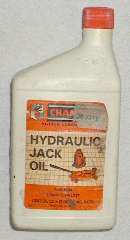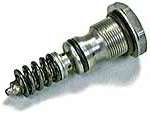The MGA With An Attitude
SHOCK ABSORBER OIL - FS-110
On 17 December 2006 at 14:01:26 UK time, ASH Andrew wrote:
"I heard that

 you can put heavy grade oil in the shocks for racing purposes. .... Any thoughts on this?"
you can put heavy grade oil in the shocks for racing purposes. .... Any thoughts on this?"
The Armstrong hydraulic shock absorbers were designed to use hydraulic oil in the viscosity range of ISO 30 to ISO 100 (equivalent to SAE 10W to SAE 30W). Commercially advertised "Shock Absorber Oil" is likely to be expensive. Motorcycle fork oil is another expensive alternative with a lot of different viscosities available (if you insist on using non-standard viscosity to defeat the factory intended function). Otherwise hydraulic jack oil works well, and is cheap and readily available. You can pick it up a local discount department store, auto parts stores, surplus tool store, or anywhere that sells hydraulic jacks. The proper way to change shock damping action is to change the regulating valve. If you feel the need for competition, you can make them adjustabe.

To empty the oil from the shock, turn it upside down and operate the arm through full stroke until all fluid is expelled. To fill it turn it right side up, add oil, and operate the arm through full stroke until all air is expelled. Leave about 1/8 inch air space at top to allow for thermal expansion without blowing oil past the shaft seals.
On Posted 20 December 2006 at 17:25:26 UK time, Peter Caldwell of World Wide Auto Parts in Madison, Wisconsin, USA, posted this sage advice:
>"Using a very heavy oil will increase the stiffness, true. It can also cause the splines on the internal piston rocker shaft to strip; it can cause the flow-back poppet valves in each piston to blow apart. Ask the old timers how many shocks all of a sudden just "went dead". We've seen it many times. The weight of the original oil is very close to a 20W motor oil in flow charcteristics. You CAN use 20 or 30W motor oil. It is COMPLETELY compatible with all of the seals. A much better choice is hydraulic fork oil or hydraulic pump oils, as you'd use in hydrostatic transmissions or hydrailc rams on heavy equipment. These have the necessary anti-foaming agents and are suited for the use. Do not exceed 30W.
>
>The better solution to increasing damping rate is to modify or replace the valves. You can find "heavy duty" valves at the usual suspects. They are really standard valves for heavier cars."
| |
ISO 22 = SAE 5
ISO 32 = SAE 10
ISO 46 = SAE 15
ISO 68 = SAE 20
ISO 100 = SAE 30
ISO 150 = SAE 40
ISO 220 = SAE 50
|
Addendum August 2009:
Hydraulic jack oil is ISO 32 hydraulic oil. ISO 32 is equivelant to SAE 10W. I have been using it for more than 20 years with good results. If you want to uprate to stiffer shocks you might do okay with ISO 68-70 hydraulic oil (SAE 20W) on consistently rough roads. Do NOT install oil thicker that ISO 100 or SAE 30W, as that can lead to broken internal parts of the shock absorber (not to mention extremely harsh ride). Do NOT install oil thinner than ISO 32 (SAE 10W), as that will not have sufficient wear resistance at high temperature. Hydraulic oil is recommended over engine oil due to anti-foaming ingredients, high temperature tolerance and non-detergent.
ChevronTexaco Mechanism LPS® ISO 32 Hydraulic Oil
Viscosity Measurement 153 -- Viscosity Index; ASTM D2270
Saybolt Viscosity at 100°F: 155 SUS
Saybolt Viscosity at 210°F: 46.6 SUS
Kinematic Viscosity at 40°C (104°F): 30.4 cSt -- ASTM D445
Kinematic Viscosity at 100°C (212°F): 6.10 cSt -- ASTM D445
Pour Point: -48.0°C, -54.4°F -- ASTM D97
Flash Point: 220°C, 428°F -- ASTM D92
MOTULE - Fork Oil Expert Heavy 20 W - (Product Code 8220)
PHYSICAL AND CHEMICAL PROPERTIES
Form: liquid - Colour: amber
Kinematic Viscosity at 40°C (104°F): 78 mm²/s -- ASTM D445
Pour point: -24°C, -11.2°F -- ASTM D97
Flash point: 244°C, 471°F -- ASTM D9
Aside from about 2x difference in viscosity (much stiffer ride), you might notice a significant difference in Pour Point temperature. The thicker oil will be very much stiffer at sub freezing temperatures. If you were contemplating putting 30W oil in your shock absorbers, you probably wouldn't want to drive it in the winter time.
|

 you can put heavy grade oil in the shocks for racing purposes. .... Any thoughts on this?"
you can put heavy grade oil in the shocks for racing purposes. .... Any thoughts on this?" 